The Impact of Recent Bail Reforms in Victoria, Australia
VerifiedAdded on 2022/12/15
|12
|3790
|442
Report
AI Summary
This report examines the recent bail law reforms in Victoria, Australia, prompted by the Bourke Street tragedy. It analyzes the shift from a presumption for bail to a presumption against it, and the expansion of offenses subject to this change. The report details the 'unacceptable risk' test, the consideration of surrounding circumstances, and the two-step tests (exceptional circumstances and compelling reasons) introduced by the amendments to the Bail Act. It discusses the impact on the unsentenced prisoner population, the role of media and political influence, and the balance between community protection and the presumption of innocence. The report references relevant legal cases and academic research to provide a comprehensive overview of the reforms and their implications for the Victorian criminal justice system. The analysis highlights the complexities of bail decisions, the challenges faced by decision-makers, and the ongoing debate surrounding the balance between public safety and individual rights.
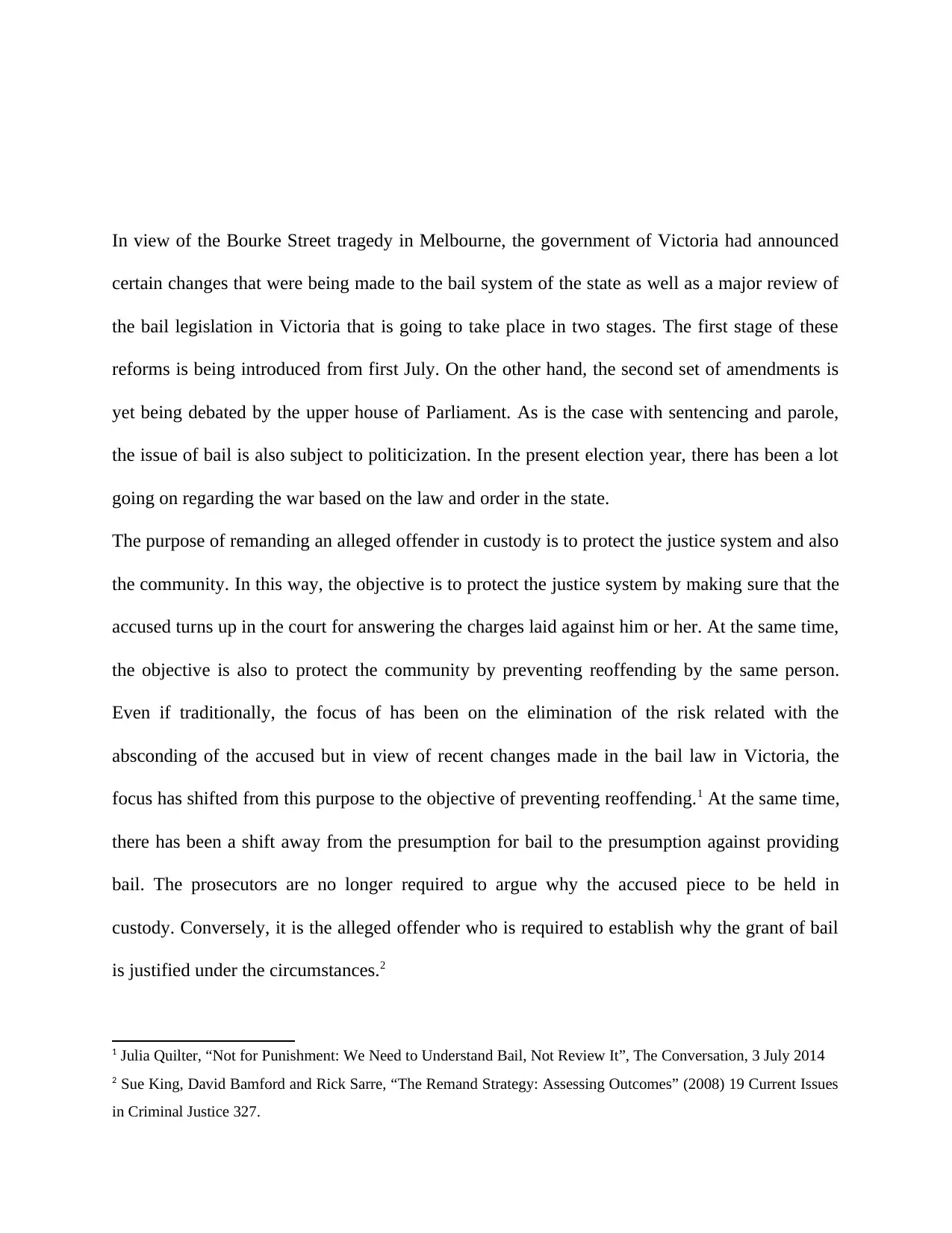
In view of the Bourke Street tragedy in Melbourne, the government of Victoria had announced
certain changes that were being made to the bail system of the state as well as a major review of
the bail legislation in Victoria that is going to take place in two stages. The first stage of these
reforms is being introduced from first July. On the other hand, the second set of amendments is
yet being debated by the upper house of Parliament. As is the case with sentencing and parole,
the issue of bail is also subject to politicization. In the present election year, there has been a lot
going on regarding the war based on the law and order in the state.
The purpose of remanding an alleged offender in custody is to protect the justice system and also
the community. In this way, the objective is to protect the justice system by making sure that the
accused turns up in the court for answering the charges laid against him or her. At the same time,
the objective is also to protect the community by preventing reoffending by the same person.
Even if traditionally, the focus of has been on the elimination of the risk related with the
absconding of the accused but in view of recent changes made in the bail law in Victoria, the
focus has shifted from this purpose to the objective of preventing reoffending.1 At the same time,
there has been a shift away from the presumption for bail to the presumption against providing
bail. The prosecutors are no longer required to argue why the accused piece to be held in
custody. Conversely, it is the alleged offender who is required to establish why the grant of bail
is justified under the circumstances.2
1 Julia Quilter, “Not for Punishment: We Need to Understand Bail, Not Review It”, The Conversation, 3 July 2014
2 Sue King, David Bamford and Rick Sarre, “The Remand Strategy: Assessing Outcomes” (2008) 19 Current Issues
in Criminal Justice 327.
certain changes that were being made to the bail system of the state as well as a major review of
the bail legislation in Victoria that is going to take place in two stages. The first stage of these
reforms is being introduced from first July. On the other hand, the second set of amendments is
yet being debated by the upper house of Parliament. As is the case with sentencing and parole,
the issue of bail is also subject to politicization. In the present election year, there has been a lot
going on regarding the war based on the law and order in the state.
The purpose of remanding an alleged offender in custody is to protect the justice system and also
the community. In this way, the objective is to protect the justice system by making sure that the
accused turns up in the court for answering the charges laid against him or her. At the same time,
the objective is also to protect the community by preventing reoffending by the same person.
Even if traditionally, the focus of has been on the elimination of the risk related with the
absconding of the accused but in view of recent changes made in the bail law in Victoria, the
focus has shifted from this purpose to the objective of preventing reoffending.1 At the same time,
there has been a shift away from the presumption for bail to the presumption against providing
bail. The prosecutors are no longer required to argue why the accused piece to be held in
custody. Conversely, it is the alleged offender who is required to establish why the grant of bail
is justified under the circumstances.2
1 Julia Quilter, “Not for Punishment: We Need to Understand Bail, Not Review It”, The Conversation, 3 July 2014
2 Sue King, David Bamford and Rick Sarre, “The Remand Strategy: Assessing Outcomes” (2008) 19 Current Issues
in Criminal Justice 327.
Paraphrase This Document
Need a fresh take? Get an instant paraphrase of this document with our AI Paraphraser
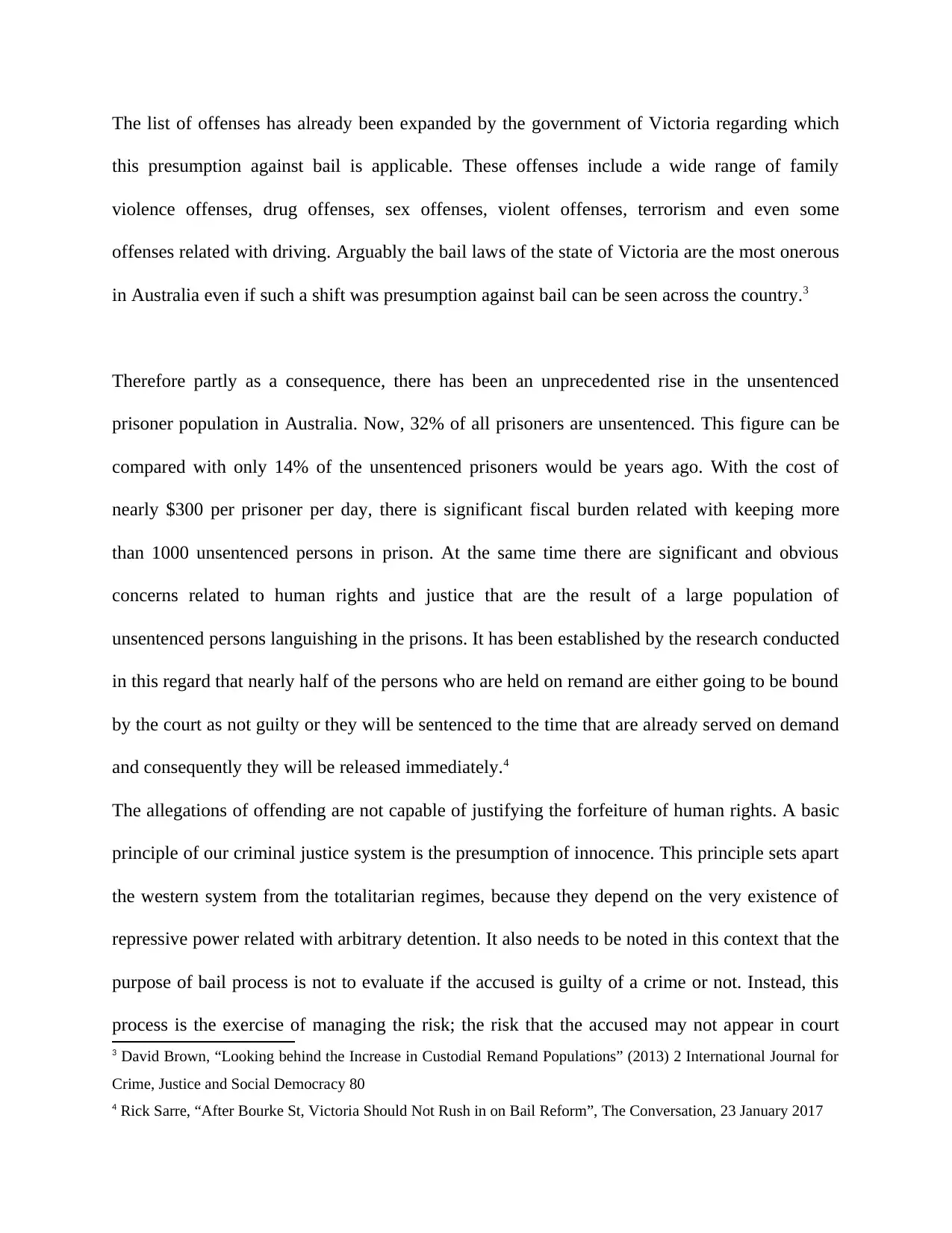
The list of offenses has already been expanded by the government of Victoria regarding which
this presumption against bail is applicable. These offenses include a wide range of family
violence offenses, drug offenses, sex offenses, violent offenses, terrorism and even some
offenses related with driving. Arguably the bail laws of the state of Victoria are the most onerous
in Australia even if such a shift was presumption against bail can be seen across the country.3
Therefore partly as a consequence, there has been an unprecedented rise in the unsentenced
prisoner population in Australia. Now, 32% of all prisoners are unsentenced. This figure can be
compared with only 14% of the unsentenced prisoners would be years ago. With the cost of
nearly $300 per prisoner per day, there is significant fiscal burden related with keeping more
than 1000 unsentenced persons in prison. At the same time there are significant and obvious
concerns related to human rights and justice that are the result of a large population of
unsentenced persons languishing in the prisons. It has been established by the research conducted
in this regard that nearly half of the persons who are held on remand are either going to be bound
by the court as not guilty or they will be sentenced to the time that are already served on demand
and consequently they will be released immediately.4
The allegations of offending are not capable of justifying the forfeiture of human rights. A basic
principle of our criminal justice system is the presumption of innocence. This principle sets apart
the western system from the totalitarian regimes, because they depend on the very existence of
repressive power related with arbitrary detention. It also needs to be noted in this context that the
purpose of bail process is not to evaluate if the accused is guilty of a crime or not. Instead, this
process is the exercise of managing the risk; the risk that the accused may not appear in court
3 David Brown, “Looking behind the Increase in Custodial Remand Populations” (2013) 2 International Journal for
Crime, Justice and Social Democracy 80
4 Rick Sarre, “After Bourke St, Victoria Should Not Rush in on Bail Reform”, The Conversation, 23 January 2017
this presumption against bail is applicable. These offenses include a wide range of family
violence offenses, drug offenses, sex offenses, violent offenses, terrorism and even some
offenses related with driving. Arguably the bail laws of the state of Victoria are the most onerous
in Australia even if such a shift was presumption against bail can be seen across the country.3
Therefore partly as a consequence, there has been an unprecedented rise in the unsentenced
prisoner population in Australia. Now, 32% of all prisoners are unsentenced. This figure can be
compared with only 14% of the unsentenced prisoners would be years ago. With the cost of
nearly $300 per prisoner per day, there is significant fiscal burden related with keeping more
than 1000 unsentenced persons in prison. At the same time there are significant and obvious
concerns related to human rights and justice that are the result of a large population of
unsentenced persons languishing in the prisons. It has been established by the research conducted
in this regard that nearly half of the persons who are held on remand are either going to be bound
by the court as not guilty or they will be sentenced to the time that are already served on demand
and consequently they will be released immediately.4
The allegations of offending are not capable of justifying the forfeiture of human rights. A basic
principle of our criminal justice system is the presumption of innocence. This principle sets apart
the western system from the totalitarian regimes, because they depend on the very existence of
repressive power related with arbitrary detention. It also needs to be noted in this context that the
purpose of bail process is not to evaluate if the accused is guilty of a crime or not. Instead, this
process is the exercise of managing the risk; the risk that the accused may not appear in court
3 David Brown, “Looking behind the Increase in Custodial Remand Populations” (2013) 2 International Journal for
Crime, Justice and Social Democracy 80
4 Rick Sarre, “After Bourke St, Victoria Should Not Rush in on Bail Reform”, The Conversation, 23 January 2017
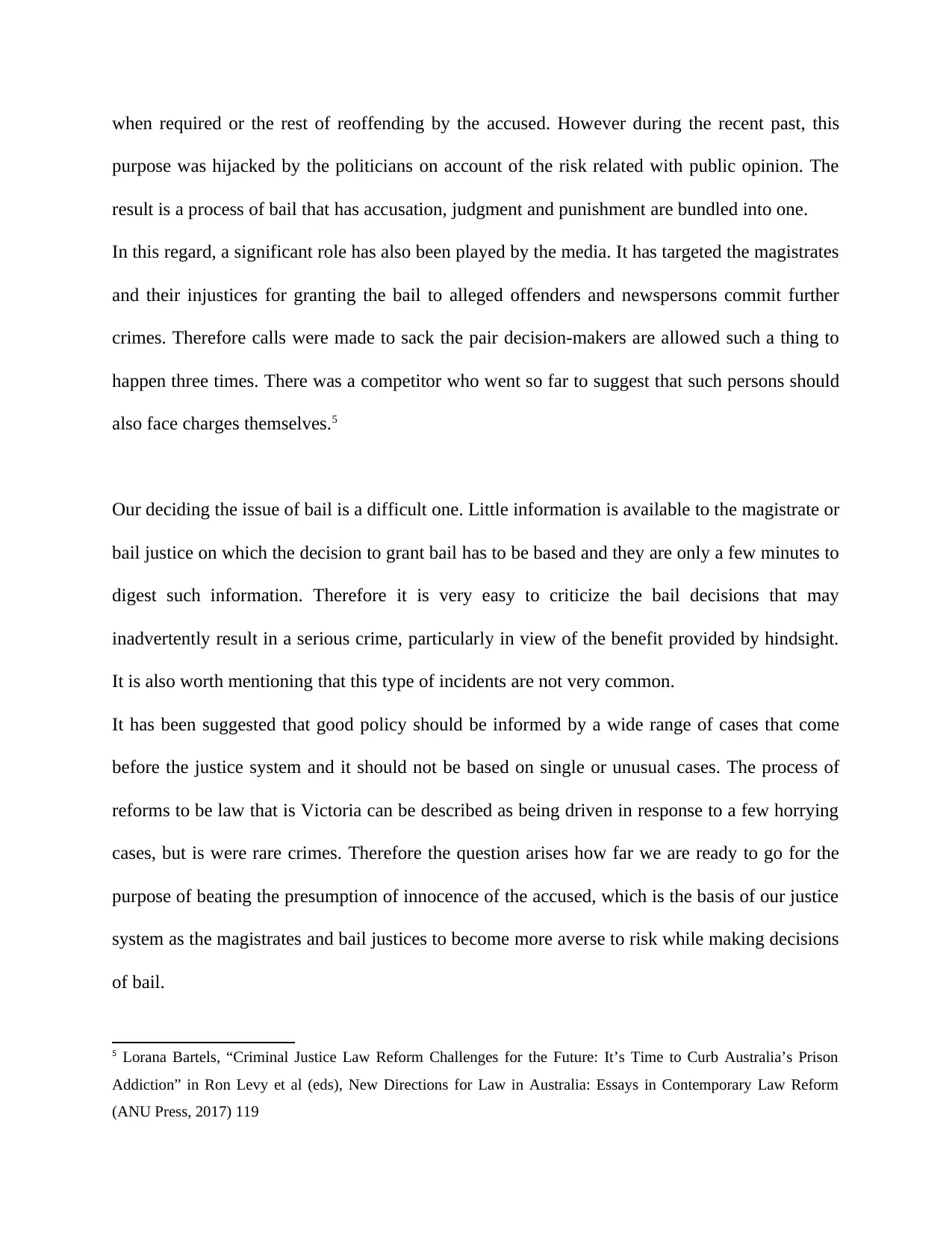
when required or the rest of reoffending by the accused. However during the recent past, this
purpose was hijacked by the politicians on account of the risk related with public opinion. The
result is a process of bail that has accusation, judgment and punishment are bundled into one.
In this regard, a significant role has also been played by the media. It has targeted the magistrates
and their injustices for granting the bail to alleged offenders and newspersons commit further
crimes. Therefore calls were made to sack the pair decision-makers are allowed such a thing to
happen three times. There was a competitor who went so far to suggest that such persons should
also face charges themselves.5
Our deciding the issue of bail is a difficult one. Little information is available to the magistrate or
bail justice on which the decision to grant bail has to be based and they are only a few minutes to
digest such information. Therefore it is very easy to criticize the bail decisions that may
inadvertently result in a serious crime, particularly in view of the benefit provided by hindsight.
It is also worth mentioning that this type of incidents are not very common.
It has been suggested that good policy should be informed by a wide range of cases that come
before the justice system and it should not be based on single or unusual cases. The process of
reforms to be law that is Victoria can be described as being driven in response to a few horrying
cases, but is were rare crimes. Therefore the question arises how far we are ready to go for the
purpose of beating the presumption of innocence of the accused, which is the basis of our justice
system as the magistrates and bail justices to become more averse to risk while making decisions
of bail.
5 Lorana Bartels, “Criminal Justice Law Reform Challenges for the Future: It’s Time to Curb Australia’s Prison
Addiction” in Ron Levy et al (eds), New Directions for Law in Australia: Essays in Contemporary Law Reform
(ANU Press, 2017) 119
purpose was hijacked by the politicians on account of the risk related with public opinion. The
result is a process of bail that has accusation, judgment and punishment are bundled into one.
In this regard, a significant role has also been played by the media. It has targeted the magistrates
and their injustices for granting the bail to alleged offenders and newspersons commit further
crimes. Therefore calls were made to sack the pair decision-makers are allowed such a thing to
happen three times. There was a competitor who went so far to suggest that such persons should
also face charges themselves.5
Our deciding the issue of bail is a difficult one. Little information is available to the magistrate or
bail justice on which the decision to grant bail has to be based and they are only a few minutes to
digest such information. Therefore it is very easy to criticize the bail decisions that may
inadvertently result in a serious crime, particularly in view of the benefit provided by hindsight.
It is also worth mentioning that this type of incidents are not very common.
It has been suggested that good policy should be informed by a wide range of cases that come
before the justice system and it should not be based on single or unusual cases. The process of
reforms to be law that is Victoria can be described as being driven in response to a few horrying
cases, but is were rare crimes. Therefore the question arises how far we are ready to go for the
purpose of beating the presumption of innocence of the accused, which is the basis of our justice
system as the magistrates and bail justices to become more averse to risk while making decisions
of bail.
5 Lorana Bartels, “Criminal Justice Law Reform Challenges for the Future: It’s Time to Curb Australia’s Prison
Addiction” in Ron Levy et al (eds), New Directions for Law in Australia: Essays in Contemporary Law Reform
(ANU Press, 2017) 119
⊘ This is a preview!⊘
Do you want full access?
Subscribe today to unlock all pages.

Trusted by 1+ million students worldwide
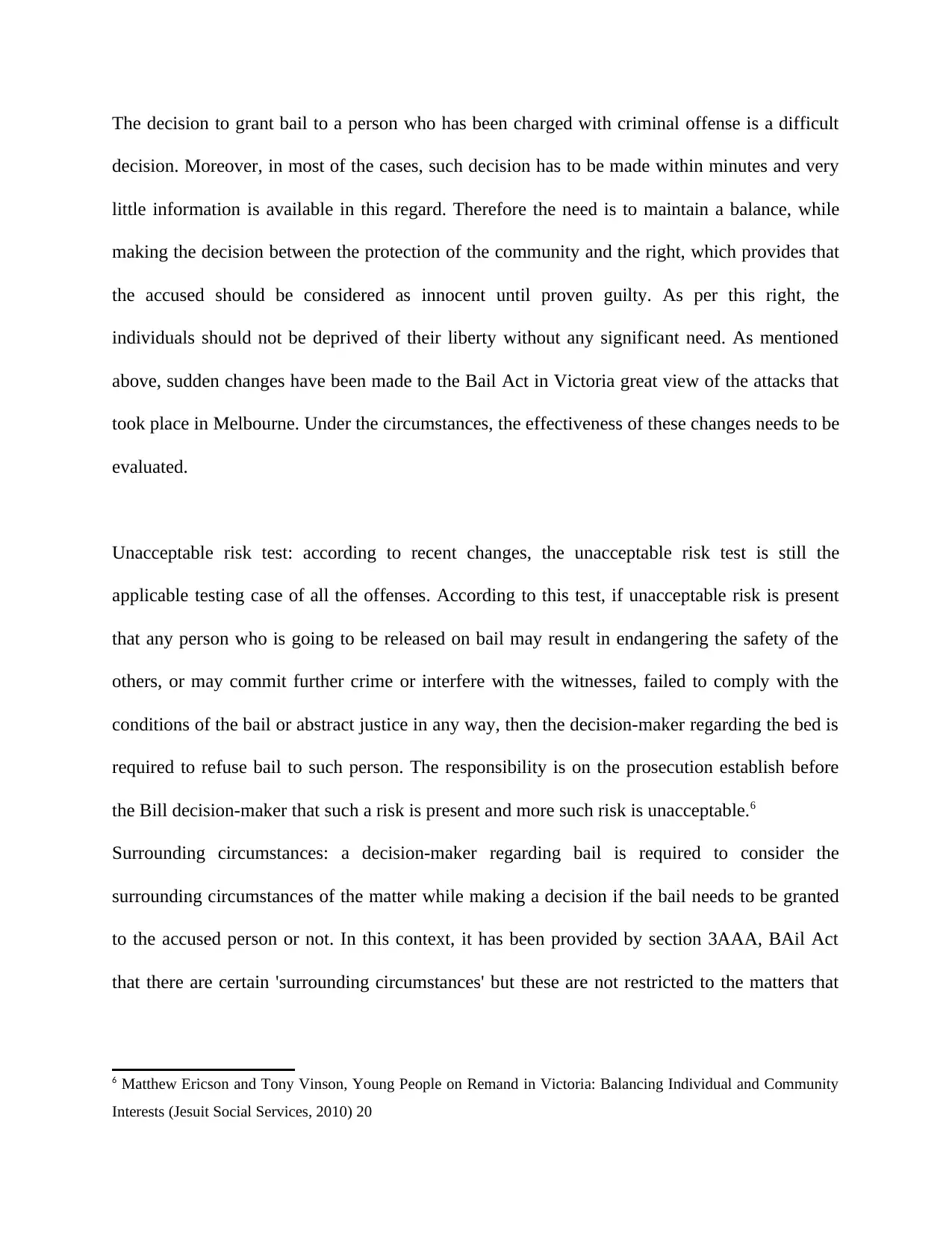
The decision to grant bail to a person who has been charged with criminal offense is a difficult
decision. Moreover, in most of the cases, such decision has to be made within minutes and very
little information is available in this regard. Therefore the need is to maintain a balance, while
making the decision between the protection of the community and the right, which provides that
the accused should be considered as innocent until proven guilty. As per this right, the
individuals should not be deprived of their liberty without any significant need. As mentioned
above, sudden changes have been made to the Bail Act in Victoria great view of the attacks that
took place in Melbourne. Under the circumstances, the effectiveness of these changes needs to be
evaluated.
Unacceptable risk test: according to recent changes, the unacceptable risk test is still the
applicable testing case of all the offenses. According to this test, if unacceptable risk is present
that any person who is going to be released on bail may result in endangering the safety of the
others, or may commit further crime or interfere with the witnesses, failed to comply with the
conditions of the bail or abstract justice in any way, then the decision-maker regarding the bed is
required to refuse bail to such person. The responsibility is on the prosecution establish before
the Bill decision-maker that such a risk is present and more such risk is unacceptable.6
Surrounding circumstances: a decision-maker regarding bail is required to consider the
surrounding circumstances of the matter while making a decision if the bail needs to be granted
to the accused person or not. In this context, it has been provided by section 3AAA, BAil Act
that there are certain 'surrounding circumstances' but these are not restricted to the matters that
6 Matthew Ericson and Tony Vinson, Young People on Remand in Victoria: Balancing Individual and Community
Interests (Jesuit Social Services, 2010) 20
decision. Moreover, in most of the cases, such decision has to be made within minutes and very
little information is available in this regard. Therefore the need is to maintain a balance, while
making the decision between the protection of the community and the right, which provides that
the accused should be considered as innocent until proven guilty. As per this right, the
individuals should not be deprived of their liberty without any significant need. As mentioned
above, sudden changes have been made to the Bail Act in Victoria great view of the attacks that
took place in Melbourne. Under the circumstances, the effectiveness of these changes needs to be
evaluated.
Unacceptable risk test: according to recent changes, the unacceptable risk test is still the
applicable testing case of all the offenses. According to this test, if unacceptable risk is present
that any person who is going to be released on bail may result in endangering the safety of the
others, or may commit further crime or interfere with the witnesses, failed to comply with the
conditions of the bail or abstract justice in any way, then the decision-maker regarding the bed is
required to refuse bail to such person. The responsibility is on the prosecution establish before
the Bill decision-maker that such a risk is present and more such risk is unacceptable.6
Surrounding circumstances: a decision-maker regarding bail is required to consider the
surrounding circumstances of the matter while making a decision if the bail needs to be granted
to the accused person or not. In this context, it has been provided by section 3AAA, BAil Act
that there are certain 'surrounding circumstances' but these are not restricted to the matters that
6 Matthew Ericson and Tony Vinson, Young People on Remand in Victoria: Balancing Individual and Community
Interests (Jesuit Social Services, 2010) 20
Paraphrase This Document
Need a fresh take? Get an instant paraphrase of this document with our AI Paraphraser
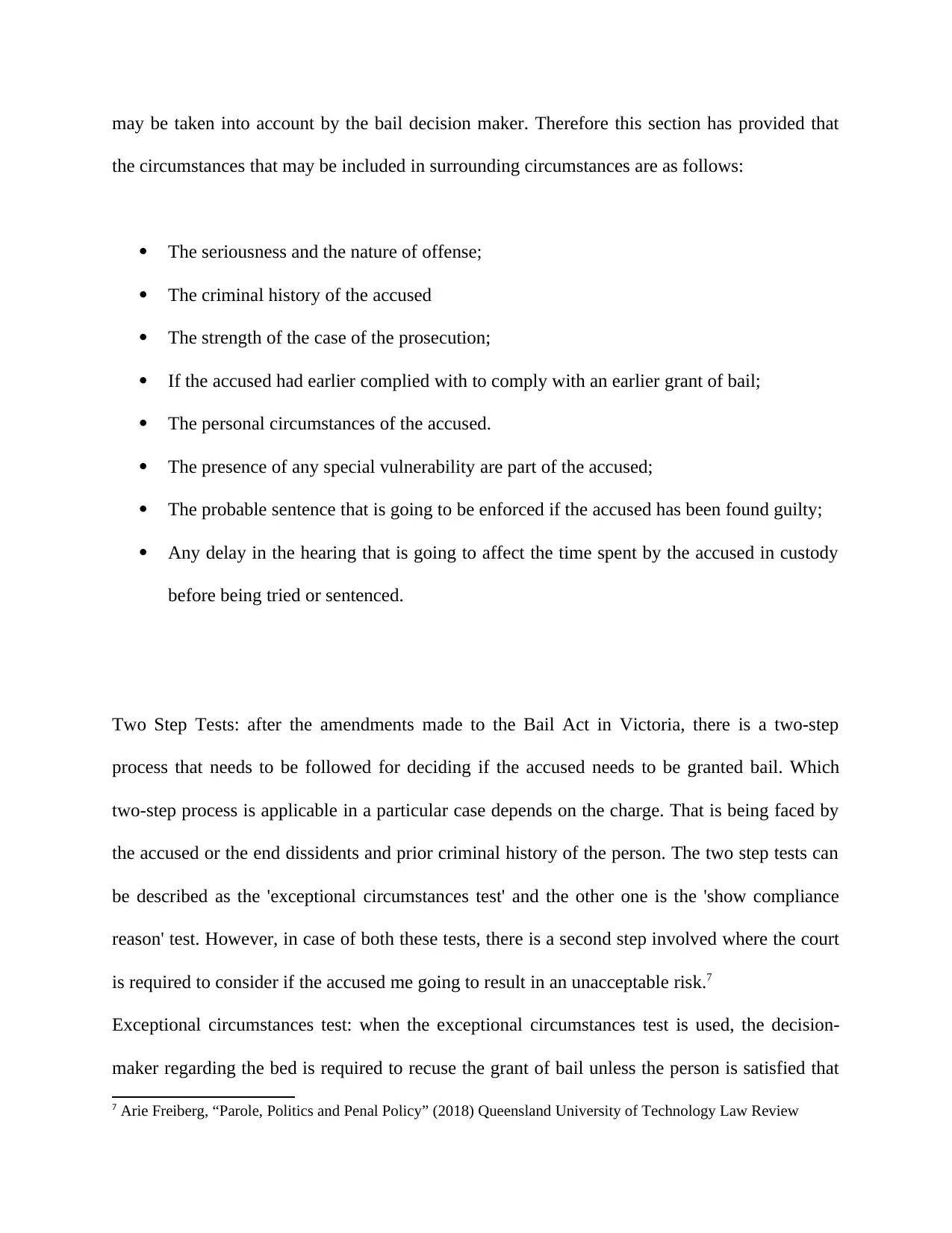
may be taken into account by the bail decision maker. Therefore this section has provided that
the circumstances that may be included in surrounding circumstances are as follows:
The seriousness and the nature of offense;
The criminal history of the accused
The strength of the case of the prosecution;
If the accused had earlier complied with to comply with an earlier grant of bail;
The personal circumstances of the accused.
The presence of any special vulnerability are part of the accused;
The probable sentence that is going to be enforced if the accused has been found guilty;
Any delay in the hearing that is going to affect the time spent by the accused in custody
before being tried or sentenced.
Two Step Tests: after the amendments made to the Bail Act in Victoria, there is a two-step
process that needs to be followed for deciding if the accused needs to be granted bail. Which
two-step process is applicable in a particular case depends on the charge. That is being faced by
the accused or the end dissidents and prior criminal history of the person. The two step tests can
be described as the 'exceptional circumstances test' and the other one is the 'show compliance
reason' test. However, in case of both these tests, there is a second step involved where the court
is required to consider if the accused me going to result in an unacceptable risk.7
Exceptional circumstances test: when the exceptional circumstances test is used, the decision-
maker regarding the bed is required to recuse the grant of bail unless the person is satisfied that
7 Arie Freiberg, “Parole, Politics and Penal Policy” (2018) Queensland University of Technology Law Review
the circumstances that may be included in surrounding circumstances are as follows:
The seriousness and the nature of offense;
The criminal history of the accused
The strength of the case of the prosecution;
If the accused had earlier complied with to comply with an earlier grant of bail;
The personal circumstances of the accused.
The presence of any special vulnerability are part of the accused;
The probable sentence that is going to be enforced if the accused has been found guilty;
Any delay in the hearing that is going to affect the time spent by the accused in custody
before being tried or sentenced.
Two Step Tests: after the amendments made to the Bail Act in Victoria, there is a two-step
process that needs to be followed for deciding if the accused needs to be granted bail. Which
two-step process is applicable in a particular case depends on the charge. That is being faced by
the accused or the end dissidents and prior criminal history of the person. The two step tests can
be described as the 'exceptional circumstances test' and the other one is the 'show compliance
reason' test. However, in case of both these tests, there is a second step involved where the court
is required to consider if the accused me going to result in an unacceptable risk.7
Exceptional circumstances test: when the exceptional circumstances test is used, the decision-
maker regarding the bed is required to recuse the grant of bail unless the person is satisfied that
7 Arie Freiberg, “Parole, Politics and Penal Policy” (2018) Queensland University of Technology Law Review
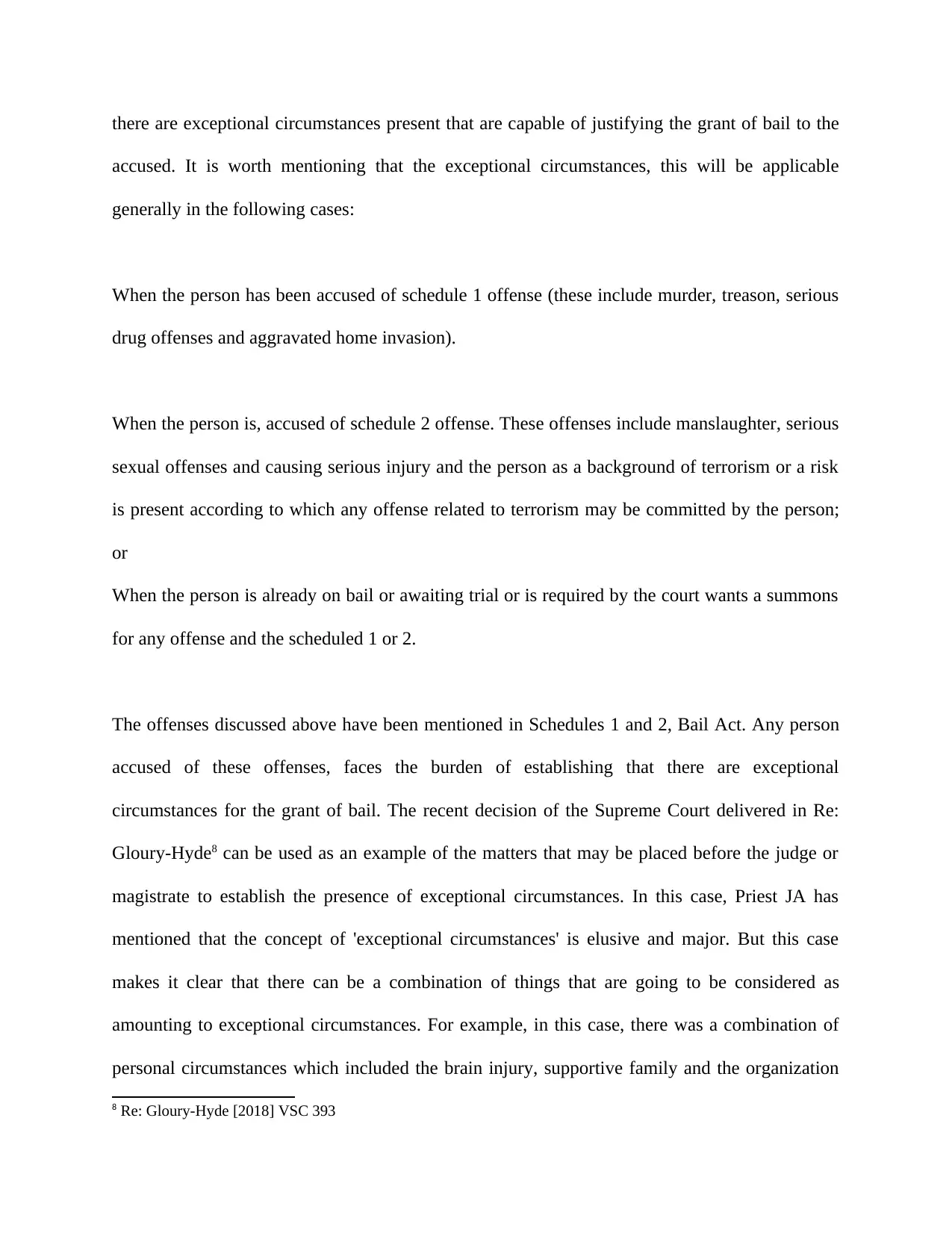
there are exceptional circumstances present that are capable of justifying the grant of bail to the
accused. It is worth mentioning that the exceptional circumstances, this will be applicable
generally in the following cases:
When the person has been accused of schedule 1 offense (these include murder, treason, serious
drug offenses and aggravated home invasion).
When the person is, accused of schedule 2 offense. These offenses include manslaughter, serious
sexual offenses and causing serious injury and the person as a background of terrorism or a risk
is present according to which any offense related to terrorism may be committed by the person;
or
When the person is already on bail or awaiting trial or is required by the court wants a summons
for any offense and the scheduled 1 or 2.
The offenses discussed above have been mentioned in Schedules 1 and 2, Bail Act. Any person
accused of these offenses, faces the burden of establishing that there are exceptional
circumstances for the grant of bail. The recent decision of the Supreme Court delivered in Re:
Gloury-Hyde8 can be used as an example of the matters that may be placed before the judge or
magistrate to establish the presence of exceptional circumstances. In this case, Priest JA has
mentioned that the concept of 'exceptional circumstances' is elusive and major. But this case
makes it clear that there can be a combination of things that are going to be considered as
amounting to exceptional circumstances. For example, in this case, there was a combination of
personal circumstances which included the brain injury, supportive family and the organization
8 Re: Gloury-Hyde [2018] VSC 393
accused. It is worth mentioning that the exceptional circumstances, this will be applicable
generally in the following cases:
When the person has been accused of schedule 1 offense (these include murder, treason, serious
drug offenses and aggravated home invasion).
When the person is, accused of schedule 2 offense. These offenses include manslaughter, serious
sexual offenses and causing serious injury and the person as a background of terrorism or a risk
is present according to which any offense related to terrorism may be committed by the person;
or
When the person is already on bail or awaiting trial or is required by the court wants a summons
for any offense and the scheduled 1 or 2.
The offenses discussed above have been mentioned in Schedules 1 and 2, Bail Act. Any person
accused of these offenses, faces the burden of establishing that there are exceptional
circumstances for the grant of bail. The recent decision of the Supreme Court delivered in Re:
Gloury-Hyde8 can be used as an example of the matters that may be placed before the judge or
magistrate to establish the presence of exceptional circumstances. In this case, Priest JA has
mentioned that the concept of 'exceptional circumstances' is elusive and major. But this case
makes it clear that there can be a combination of things that are going to be considered as
amounting to exceptional circumstances. For example, in this case, there was a combination of
personal circumstances which included the brain injury, supportive family and the organization
8 Re: Gloury-Hyde [2018] VSC 393
⊘ This is a preview!⊘
Do you want full access?
Subscribe today to unlock all pages.

Trusted by 1+ million students worldwide
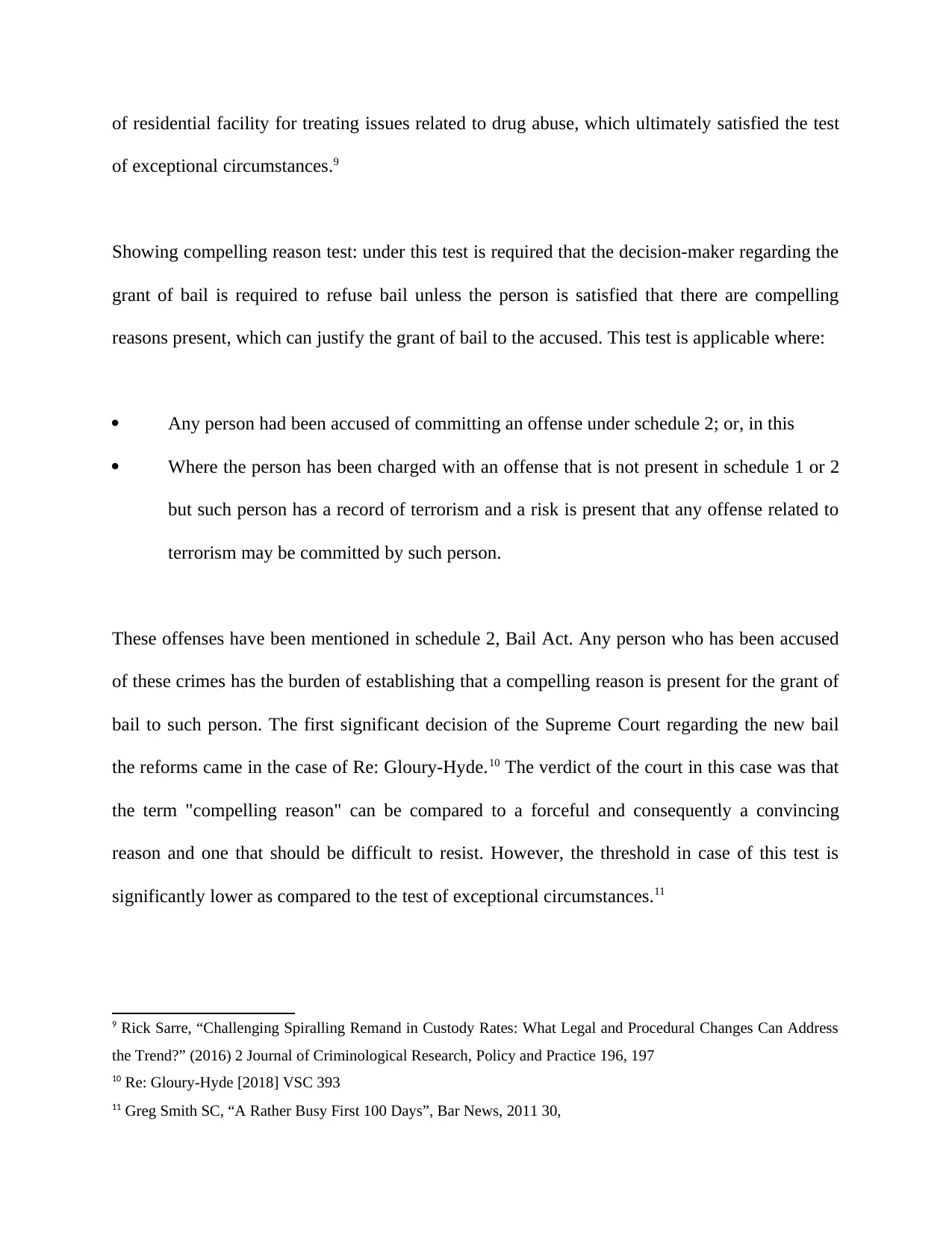
of residential facility for treating issues related to drug abuse, which ultimately satisfied the test
of exceptional circumstances.9
Showing compelling reason test: under this test is required that the decision-maker regarding the
grant of bail is required to refuse bail unless the person is satisfied that there are compelling
reasons present, which can justify the grant of bail to the accused. This test is applicable where:
Any person had been accused of committing an offense under schedule 2; or, in this
Where the person has been charged with an offense that is not present in schedule 1 or 2
but such person has a record of terrorism and a risk is present that any offense related to
terrorism may be committed by such person.
These offenses have been mentioned in schedule 2, Bail Act. Any person who has been accused
of these crimes has the burden of establishing that a compelling reason is present for the grant of
bail to such person. The first significant decision of the Supreme Court regarding the new bail
the reforms came in the case of Re: Gloury-Hyde.10 The verdict of the court in this case was that
the term "compelling reason" can be compared to a forceful and consequently a convincing
reason and one that should be difficult to resist. However, the threshold in case of this test is
significantly lower as compared to the test of exceptional circumstances.11
9 Rick Sarre, “Challenging Spiralling Remand in Custody Rates: What Legal and Procedural Changes Can Address
the Trend?” (2016) 2 Journal of Criminological Research, Policy and Practice 196, 197
10 Re: Gloury-Hyde [2018] VSC 393
11 Greg Smith SC, “A Rather Busy First 100 Days”, Bar News, 2011 30,
of exceptional circumstances.9
Showing compelling reason test: under this test is required that the decision-maker regarding the
grant of bail is required to refuse bail unless the person is satisfied that there are compelling
reasons present, which can justify the grant of bail to the accused. This test is applicable where:
Any person had been accused of committing an offense under schedule 2; or, in this
Where the person has been charged with an offense that is not present in schedule 1 or 2
but such person has a record of terrorism and a risk is present that any offense related to
terrorism may be committed by such person.
These offenses have been mentioned in schedule 2, Bail Act. Any person who has been accused
of these crimes has the burden of establishing that a compelling reason is present for the grant of
bail to such person. The first significant decision of the Supreme Court regarding the new bail
the reforms came in the case of Re: Gloury-Hyde.10 The verdict of the court in this case was that
the term "compelling reason" can be compared to a forceful and consequently a convincing
reason and one that should be difficult to resist. However, the threshold in case of this test is
significantly lower as compared to the test of exceptional circumstances.11
9 Rick Sarre, “Challenging Spiralling Remand in Custody Rates: What Legal and Procedural Changes Can Address
the Trend?” (2016) 2 Journal of Criminological Research, Policy and Practice 196, 197
10 Re: Gloury-Hyde [2018] VSC 393
11 Greg Smith SC, “A Rather Busy First 100 Days”, Bar News, 2011 30,
Paraphrase This Document
Need a fresh take? Get an instant paraphrase of this document with our AI Paraphraser
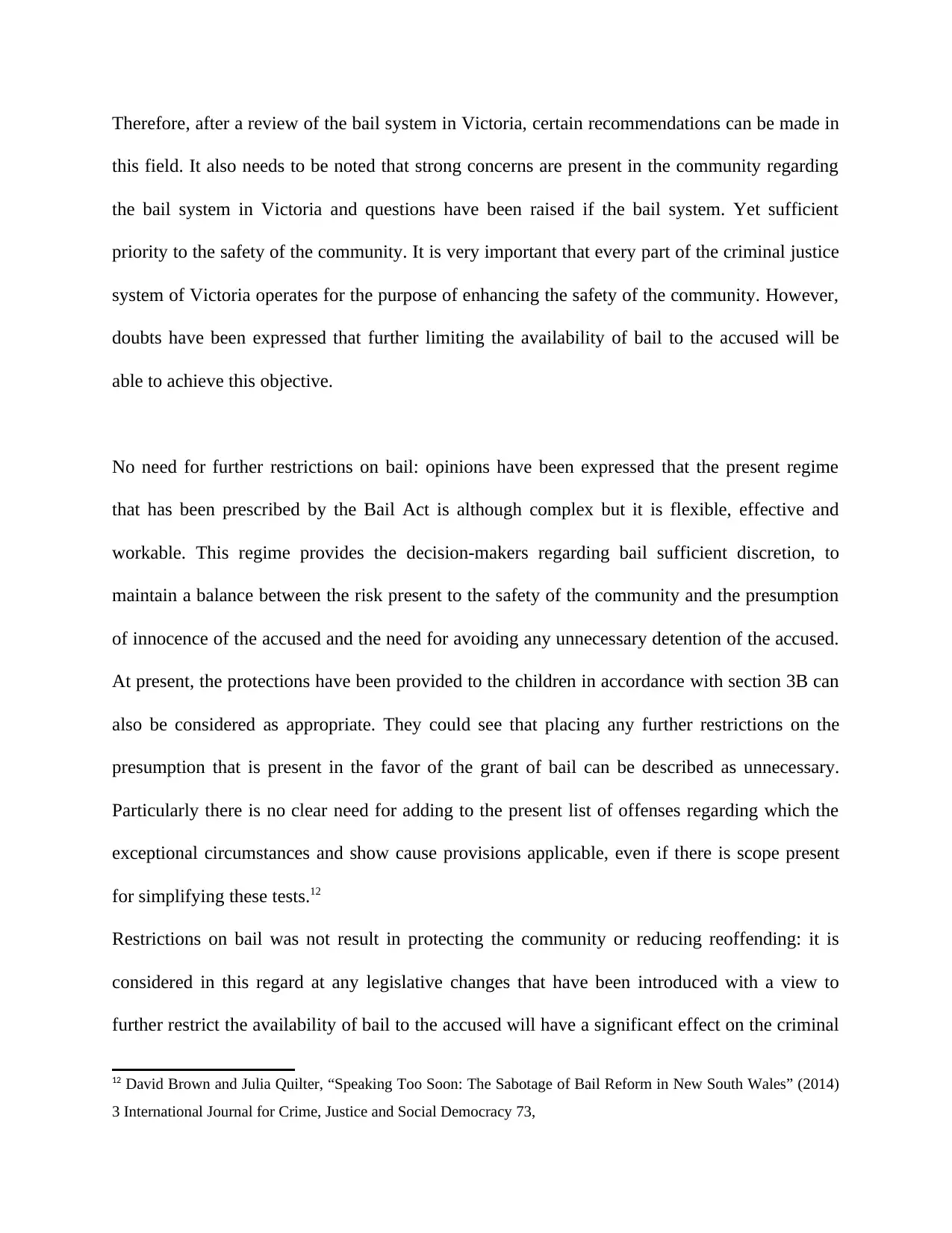
Therefore, after a review of the bail system in Victoria, certain recommendations can be made in
this field. It also needs to be noted that strong concerns are present in the community regarding
the bail system in Victoria and questions have been raised if the bail system. Yet sufficient
priority to the safety of the community. It is very important that every part of the criminal justice
system of Victoria operates for the purpose of enhancing the safety of the community. However,
doubts have been expressed that further limiting the availability of bail to the accused will be
able to achieve this objective.
No need for further restrictions on bail: opinions have been expressed that the present regime
that has been prescribed by the Bail Act is although complex but it is flexible, effective and
workable. This regime provides the decision-makers regarding bail sufficient discretion, to
maintain a balance between the risk present to the safety of the community and the presumption
of innocence of the accused and the need for avoiding any unnecessary detention of the accused.
At present, the protections have been provided to the children in accordance with section 3B can
also be considered as appropriate. They could see that placing any further restrictions on the
presumption that is present in the favor of the grant of bail can be described as unnecessary.
Particularly there is no clear need for adding to the present list of offenses regarding which the
exceptional circumstances and show cause provisions applicable, even if there is scope present
for simplifying these tests.12
Restrictions on bail was not result in protecting the community or reducing reoffending: it is
considered in this regard at any legislative changes that have been introduced with a view to
further restrict the availability of bail to the accused will have a significant effect on the criminal
12 David Brown and Julia Quilter, “Speaking Too Soon: The Sabotage of Bail Reform in New South Wales” (2014)
3 International Journal for Crime, Justice and Social Democracy 73,
this field. It also needs to be noted that strong concerns are present in the community regarding
the bail system in Victoria and questions have been raised if the bail system. Yet sufficient
priority to the safety of the community. It is very important that every part of the criminal justice
system of Victoria operates for the purpose of enhancing the safety of the community. However,
doubts have been expressed that further limiting the availability of bail to the accused will be
able to achieve this objective.
No need for further restrictions on bail: opinions have been expressed that the present regime
that has been prescribed by the Bail Act is although complex but it is flexible, effective and
workable. This regime provides the decision-makers regarding bail sufficient discretion, to
maintain a balance between the risk present to the safety of the community and the presumption
of innocence of the accused and the need for avoiding any unnecessary detention of the accused.
At present, the protections have been provided to the children in accordance with section 3B can
also be considered as appropriate. They could see that placing any further restrictions on the
presumption that is present in the favor of the grant of bail can be described as unnecessary.
Particularly there is no clear need for adding to the present list of offenses regarding which the
exceptional circumstances and show cause provisions applicable, even if there is scope present
for simplifying these tests.12
Restrictions on bail was not result in protecting the community or reducing reoffending: it is
considered in this regard at any legislative changes that have been introduced with a view to
further restrict the availability of bail to the accused will have a significant effect on the criminal
12 David Brown and Julia Quilter, “Speaking Too Soon: The Sabotage of Bail Reform in New South Wales” (2014)
3 International Journal for Crime, Justice and Social Democracy 73,
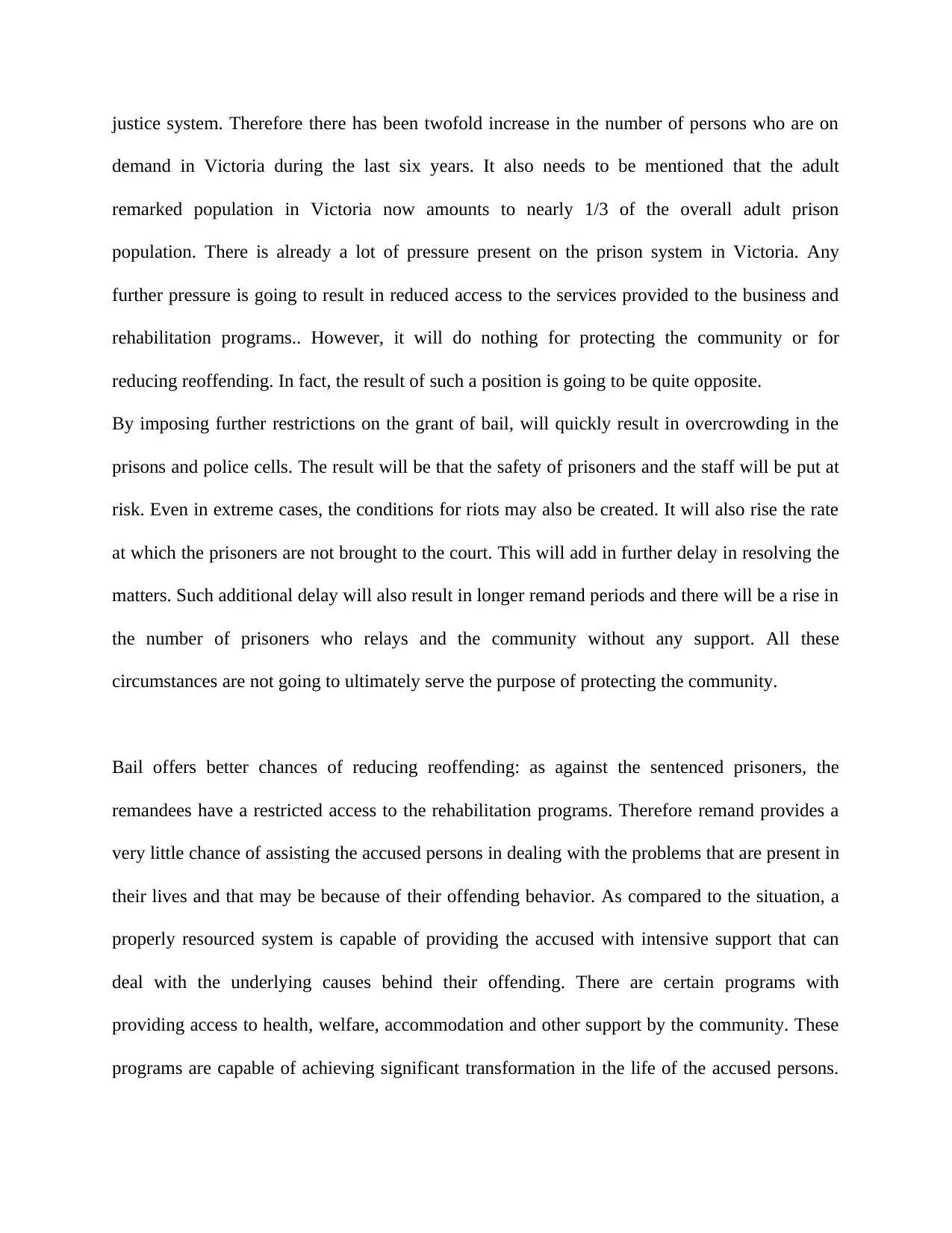
justice system. Therefore there has been twofold increase in the number of persons who are on
demand in Victoria during the last six years. It also needs to be mentioned that the adult
remarked population in Victoria now amounts to nearly 1/3 of the overall adult prison
population. There is already a lot of pressure present on the prison system in Victoria. Any
further pressure is going to result in reduced access to the services provided to the business and
rehabilitation programs.. However, it will do nothing for protecting the community or for
reducing reoffending. In fact, the result of such a position is going to be quite opposite.
By imposing further restrictions on the grant of bail, will quickly result in overcrowding in the
prisons and police cells. The result will be that the safety of prisoners and the staff will be put at
risk. Even in extreme cases, the conditions for riots may also be created. It will also rise the rate
at which the prisoners are not brought to the court. This will add in further delay in resolving the
matters. Such additional delay will also result in longer remand periods and there will be a rise in
the number of prisoners who relays and the community without any support. All these
circumstances are not going to ultimately serve the purpose of protecting the community.
Bail offers better chances of reducing reoffending: as against the sentenced prisoners, the
remandees have a restricted access to the rehabilitation programs. Therefore remand provides a
very little chance of assisting the accused persons in dealing with the problems that are present in
their lives and that may be because of their offending behavior. As compared to the situation, a
properly resourced system is capable of providing the accused with intensive support that can
deal with the underlying causes behind their offending. There are certain programs with
providing access to health, welfare, accommodation and other support by the community. These
programs are capable of achieving significant transformation in the life of the accused persons.
demand in Victoria during the last six years. It also needs to be mentioned that the adult
remarked population in Victoria now amounts to nearly 1/3 of the overall adult prison
population. There is already a lot of pressure present on the prison system in Victoria. Any
further pressure is going to result in reduced access to the services provided to the business and
rehabilitation programs.. However, it will do nothing for protecting the community or for
reducing reoffending. In fact, the result of such a position is going to be quite opposite.
By imposing further restrictions on the grant of bail, will quickly result in overcrowding in the
prisons and police cells. The result will be that the safety of prisoners and the staff will be put at
risk. Even in extreme cases, the conditions for riots may also be created. It will also rise the rate
at which the prisoners are not brought to the court. This will add in further delay in resolving the
matters. Such additional delay will also result in longer remand periods and there will be a rise in
the number of prisoners who relays and the community without any support. All these
circumstances are not going to ultimately serve the purpose of protecting the community.
Bail offers better chances of reducing reoffending: as against the sentenced prisoners, the
remandees have a restricted access to the rehabilitation programs. Therefore remand provides a
very little chance of assisting the accused persons in dealing with the problems that are present in
their lives and that may be because of their offending behavior. As compared to the situation, a
properly resourced system is capable of providing the accused with intensive support that can
deal with the underlying causes behind their offending. There are certain programs with
providing access to health, welfare, accommodation and other support by the community. These
programs are capable of achieving significant transformation in the life of the accused persons.
⊘ This is a preview!⊘
Do you want full access?
Subscribe today to unlock all pages.

Trusted by 1+ million students worldwide
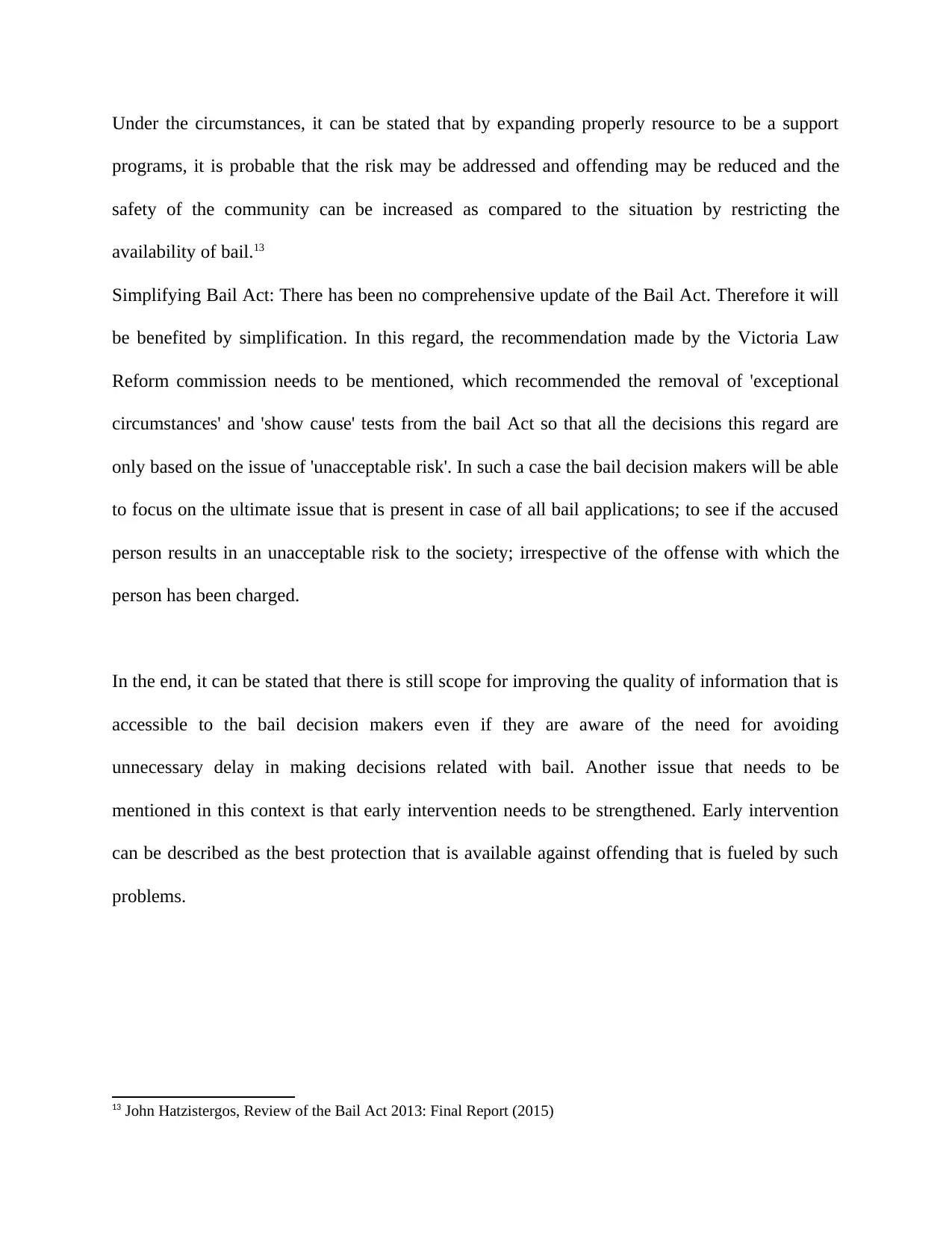
Under the circumstances, it can be stated that by expanding properly resource to be a support
programs, it is probable that the risk may be addressed and offending may be reduced and the
safety of the community can be increased as compared to the situation by restricting the
availability of bail.13
Simplifying Bail Act: There has been no comprehensive update of the Bail Act. Therefore it will
be benefited by simplification. In this regard, the recommendation made by the Victoria Law
Reform commission needs to be mentioned, which recommended the removal of 'exceptional
circumstances' and 'show cause' tests from the bail Act so that all the decisions this regard are
only based on the issue of 'unacceptable risk'. In such a case the bail decision makers will be able
to focus on the ultimate issue that is present in case of all bail applications; to see if the accused
person results in an unacceptable risk to the society; irrespective of the offense with which the
person has been charged.
In the end, it can be stated that there is still scope for improving the quality of information that is
accessible to the bail decision makers even if they are aware of the need for avoiding
unnecessary delay in making decisions related with bail. Another issue that needs to be
mentioned in this context is that early intervention needs to be strengthened. Early intervention
can be described as the best protection that is available against offending that is fueled by such
problems.
13 John Hatzistergos, Review of the Bail Act 2013: Final Report (2015)
programs, it is probable that the risk may be addressed and offending may be reduced and the
safety of the community can be increased as compared to the situation by restricting the
availability of bail.13
Simplifying Bail Act: There has been no comprehensive update of the Bail Act. Therefore it will
be benefited by simplification. In this regard, the recommendation made by the Victoria Law
Reform commission needs to be mentioned, which recommended the removal of 'exceptional
circumstances' and 'show cause' tests from the bail Act so that all the decisions this regard are
only based on the issue of 'unacceptable risk'. In such a case the bail decision makers will be able
to focus on the ultimate issue that is present in case of all bail applications; to see if the accused
person results in an unacceptable risk to the society; irrespective of the offense with which the
person has been charged.
In the end, it can be stated that there is still scope for improving the quality of information that is
accessible to the bail decision makers even if they are aware of the need for avoiding
unnecessary delay in making decisions related with bail. Another issue that needs to be
mentioned in this context is that early intervention needs to be strengthened. Early intervention
can be described as the best protection that is available against offending that is fueled by such
problems.
13 John Hatzistergos, Review of the Bail Act 2013: Final Report (2015)
Paraphrase This Document
Need a fresh take? Get an instant paraphrase of this document with our AI Paraphraser
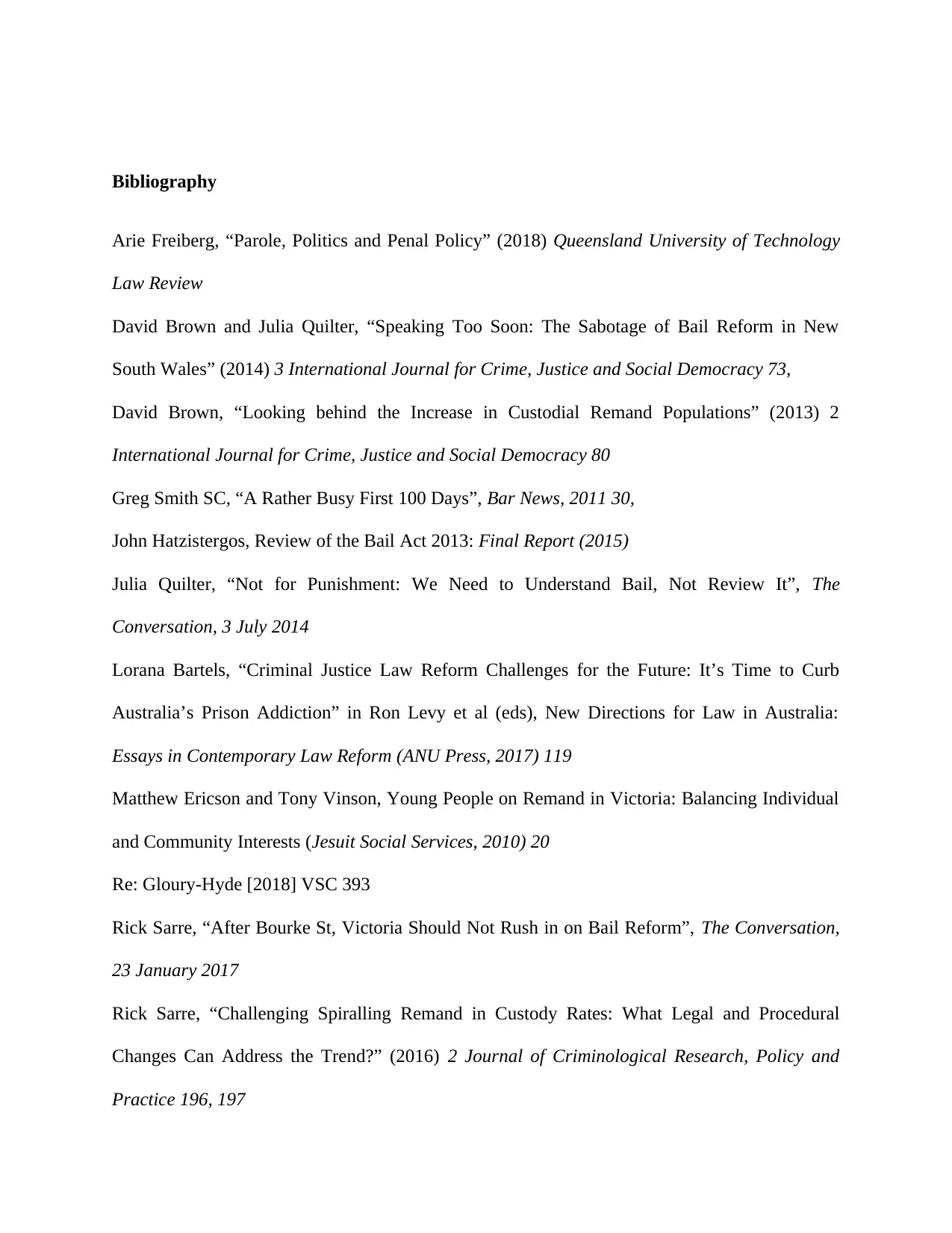
Bibliography
Arie Freiberg, “Parole, Politics and Penal Policy” (2018) Queensland University of Technology
Law Review
David Brown and Julia Quilter, “Speaking Too Soon: The Sabotage of Bail Reform in New
South Wales” (2014) 3 International Journal for Crime, Justice and Social Democracy 73,
David Brown, “Looking behind the Increase in Custodial Remand Populations” (2013) 2
International Journal for Crime, Justice and Social Democracy 80
Greg Smith SC, “A Rather Busy First 100 Days”, Bar News, 2011 30,
John Hatzistergos, Review of the Bail Act 2013: Final Report (2015)
Julia Quilter, “Not for Punishment: We Need to Understand Bail, Not Review It”, The
Conversation, 3 July 2014
Lorana Bartels, “Criminal Justice Law Reform Challenges for the Future: It’s Time to Curb
Australia’s Prison Addiction” in Ron Levy et al (eds), New Directions for Law in Australia:
Essays in Contemporary Law Reform (ANU Press, 2017) 119
Matthew Ericson and Tony Vinson, Young People on Remand in Victoria: Balancing Individual
and Community Interests (Jesuit Social Services, 2010) 20
Re: Gloury-Hyde [2018] VSC 393
Rick Sarre, “After Bourke St, Victoria Should Not Rush in on Bail Reform”, The Conversation,
23 January 2017
Rick Sarre, “Challenging Spiralling Remand in Custody Rates: What Legal and Procedural
Changes Can Address the Trend?” (2016) 2 Journal of Criminological Research, Policy and
Practice 196, 197
Arie Freiberg, “Parole, Politics and Penal Policy” (2018) Queensland University of Technology
Law Review
David Brown and Julia Quilter, “Speaking Too Soon: The Sabotage of Bail Reform in New
South Wales” (2014) 3 International Journal for Crime, Justice and Social Democracy 73,
David Brown, “Looking behind the Increase in Custodial Remand Populations” (2013) 2
International Journal for Crime, Justice and Social Democracy 80
Greg Smith SC, “A Rather Busy First 100 Days”, Bar News, 2011 30,
John Hatzistergos, Review of the Bail Act 2013: Final Report (2015)
Julia Quilter, “Not for Punishment: We Need to Understand Bail, Not Review It”, The
Conversation, 3 July 2014
Lorana Bartels, “Criminal Justice Law Reform Challenges for the Future: It’s Time to Curb
Australia’s Prison Addiction” in Ron Levy et al (eds), New Directions for Law in Australia:
Essays in Contemporary Law Reform (ANU Press, 2017) 119
Matthew Ericson and Tony Vinson, Young People on Remand in Victoria: Balancing Individual
and Community Interests (Jesuit Social Services, 2010) 20
Re: Gloury-Hyde [2018] VSC 393
Rick Sarre, “After Bourke St, Victoria Should Not Rush in on Bail Reform”, The Conversation,
23 January 2017
Rick Sarre, “Challenging Spiralling Remand in Custody Rates: What Legal and Procedural
Changes Can Address the Trend?” (2016) 2 Journal of Criminological Research, Policy and
Practice 196, 197

Sue King, David Bamford and Rick Sarre, “The Remand Strategy: Assessing Outcomes” (2008)
19 Current Issues in Criminal Justice 327.
19 Current Issues in Criminal Justice 327.
⊘ This is a preview!⊘
Do you want full access?
Subscribe today to unlock all pages.

Trusted by 1+ million students worldwide
1 out of 12
Related Documents
Your All-in-One AI-Powered Toolkit for Academic Success.
+13062052269
info@desklib.com
Available 24*7 on WhatsApp / Email
![[object Object]](/_next/static/media/star-bottom.7253800d.svg)
Unlock your academic potential
Copyright © 2020–2025 A2Z Services. All Rights Reserved. Developed and managed by ZUCOL.




